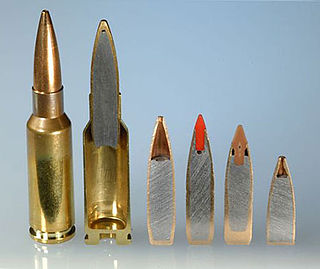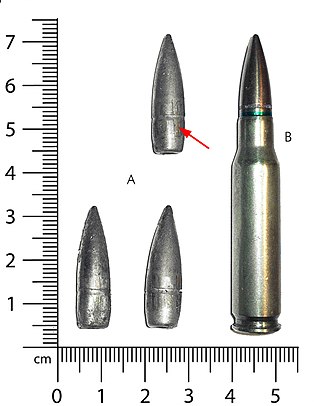Related Research Articles

The 5.56×45mm NATO is a rimless bottlenecked intermediate cartridge family developed in the late 1970s in Belgium by FN Herstal. It consists of the SS109, L110, and SS111 cartridges. On 28 October 1980, under STANAG 4172, it was standardized as the second standard service rifle cartridge for NATO forces as well as many non-NATO countries. Though they are not entirely identical, the 5.56×45mm NATO cartridge family was derived from and is dimensionally similar to the .223 Remington cartridge designed by Remington Arms in the early 1960s.

The .45 ACP, also known as .45 Auto, .45 Automatic, or 11.43×23mm is a rimless straight-walled handgun cartridge designed by John Moses Browning in 1904, for use in his prototype Colt semi-automatic pistol. After successful military trials, it was adopted as the standard chambering for Colt's M1911 pistol. The round was developed due to a lack of stopping power experienced in the Moro Rebellion in places like Sulu. The issued ammunition, .38 Long Colt, had proved inadequate, motivating the search for a better cartridge. This experience and the Thompson–LaGarde Tests of 1904 led the Army and the Cavalry to decide that a minimum of .45 caliber was required in a new handgun cartridge.
The .30-06 Springfield cartridge, 7.62×63mm in metric notation, and called the .30 Gov't '06 by Winchester, was introduced to the United States Army in 1906 and later standardized; it remained in military use until the late 1970s. The ".30" refers to the caliber of the bullet in inches, .300 and the "06" refers to the year the cartridge was adopted, 1906. It replaced the .30-03, 6mm Lee Navy, and .30-40 Krag cartridges. The .30-06 remained the U.S. Army's primary rifle and machine gun cartridge for nearly 50 years before being replaced by the 7.62×51mm NATO and 5.56×45mm NATO, both of which remain in current U.S. and NATO service. It remains a very popular sporting round, with ammunition produced by all major manufacturers.

The 7.62×25mm Tokarev cartridge is a Soviet rimless bottleneck pistol cartridge widely used in former Soviet states and in China, among other countries. The cartridge has since been replaced in most capacities by the 9×18mm Makarov in Russian service.

The .303 British or 7.7×56mmR, is a .303-inch (7.7 mm) calibre rimmed rifle cartridge. The .303 inch bore diameter is measured between rifling lands as is the common practice in Europe which follows the traditional black powder convention.

A headstamp is the markings on the bottom of a cartridge case designed for a firearm. It usually tells who manufactured the case. If it is a civilian case it often also tells the caliber: if it is military, the year of manufacture is often added.
A filling factory was a manufacturing plant that specialised in filling various munitions, such as bombs, shells, cartridges, pyrotechnics, and screening smokes. In the United Kingdom, during both world wars of the 20th century, the majority of the employees were women.
The 5.45×39mm cartridge is a rimless bottlenecked intermediate cartridge. It was introduced into service in 1974 by the Soviet Union for use with the new AK-74. The 5.45×39mm gradually supplemented and then largely replaced the 7.62×39mm cartridge in Soviet and Warsaw Pact service as the primary military service rifle cartridge.

The 6.5mm Grendel is an intermediate cartridge jointly designed by British-American armorer Bill Alexander, competitive shooter Arne Brennan and Lapua ballistician Janne Pohjoispää, as a low-recoil, high-precision rifle cartridge specifically for the AR-15 platform at medium/long range. It is an improved variation of the 6.5mm PPC.
Royal Ordnance plc was formed on 2 January 1985 as a public corporation, owning the majority of what until then were the remaining United Kingdom government-owned Royal Ordnance Factories which manufactured explosives, ammunition, small arms including the Lee–Enfield rifle, guns and military vehicles such as tanks. It owned some 16 factories; and employed about 19,000 staff.

The SME Ordnance Sdn Bhd (SMEO), formerly known as Syarikat Malaysia Explosive Sdn Bhd, is a Malaysian defence company that specialises in the manufacturing and marketing of ordnance. The company is located in Batu Arang, Selangor.
Bangladesh Ordnance Factories (BOF) is the largest industrial supplier of the Bangladesh Army. Situated in Gazipur, it produces arms, ammunition, and equipment for the Bangladesh Armed Forces.

The 7.62×51mm NATO is a rimless, bottlenecked rifle cartridge. It is a standard for small arms among NATO countries.

The FN 5.7×28mm is a small-caliber, high-velocity, smokeless-powder, rebated, bottleneck, centerfire cartridge designed for pistols and personal defense weapons (PDW) uses, manufactured by FN Herstal. It is similar in length to the .22 WMR and .22 Hornet. Unlike many new cartridges, it has no parent case; the complete package was developed from scratch by FN.
The 4.85×49mm is an experimental intermediate firearm cartridge made by the United Kingdom for the Individual Weapon Project, which became the SA80 series of small arms.

The Small Arms Ammunition Factories (SAAF) were ammunition manufacturing plants run by the Australian government. Nearly all of their production was for domestic use by their military, the police forces, and government-appointed agents.
References
- 1 2 3 "Site of BAE's Cheshire factory to be sold". The Manufacturer. 15 October 2014. Retrieved 4 August 2020.
- ↑ "BAE in £2bn MoD ammunition deal". BBC News. 20 August 2008. Retrieved 22 May 2010.
- ↑ "Radway Green modernisation to improve munitions delivery". Advance ADS. 30 September 2011. Retrieved 4 August 2020.
- ↑ Frost, Richard (8 June 2017). "HUGE BULLET FACTORY SOLD FOR MORE THAN £50M". Business Insider. Retrieved 4 August 2020.
- ↑ Prior, Grant (4 August 2020). "Plans unveiled for new 40-acre Crewe warehouse scheme". Construction Enquirer. Retrieved 4 August 2020.
- 1 2 "Six years' jail for ROF arms thefts". Law. The Times. No. 62042. London. 22 January 1985. col B, p. 4.
- 1 2 Richard Evans (18 June 1985). "Tighter security at nuclear weapons bases disclosed". The Times. No. 62167. London. col A, p. 5.
- ↑ "Extra security for arms factories". The Times. No. 62061. London. 13 February 1985. col A, p. 4.
- ↑ "British Military Small Arms Ammo - 7.62mm NATO Ball & Short Range".